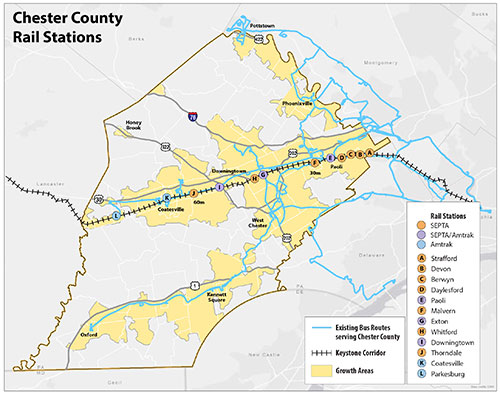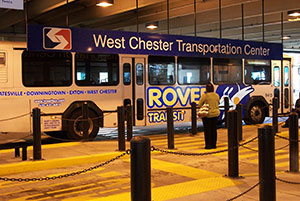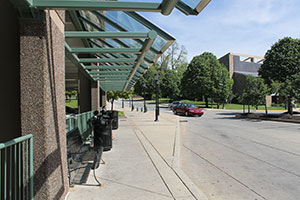Rail Stations & Transportation Centers
Rail stations and transportation centers serve as the intermodal hubs of the public transportation system in Chester County. They are the primary locations for where Chester County residents access either SEPTA or Amtrak services along the central commuter rail spine of the Keystone Corridor, or from where transit users may board one or more or transfer between the bus routes that serve the county and beyond.
This design element focuses on rail stations and transportation centers and the amenities they may provide to improve the built environment for transit users and their experience using the public transportation system.
The quality of a public transit ride is defined by all aspects of a rider's experience, from the time of departure to arrival at the destination. Beyond a rider's experience in the transit vehicle, there are two additional significant components to a "full" transit ride: the connection between a transit stop and one's origin/destination; and the experience waiting for the arrival of the transit vehicle. In this context, the amenities at rail stations and transportation centers have significant roles regarding the quality of public transit in Chester County.
Rail Stations
Rail Station
A stop along a commuter rail line where trains load or unload passengers.
There are two passenger rail providers that serve Chester County. Amtrak provides regional and intercity service on the Keystone Corridor between Philadelphia and Harrisburg with additional intra- and interstate connections. SEPTA operates the Paoli/Thorndale commuter rail service on the same rail line extending between Philadelphia and Thorndale with regional connections in Philadelphia. This rail right-of-way is owned by Amtrak and extends on an east/west axis through the central portion of Chester County.
There are twelve existing passenger rail stations in Chester County (listed below from east to west). Two are served by Amtrak only, seven are served by SEPTA only, and three are served by both agencies:

- Strafford: Old Eagle School & Crestline Roads
- Devon: Lancaster Ave. & Devon State Rd.
- Berwyn: Lancaster Ave. & Main Ave.
- Daylesford: Lancaster Ave. & Glenn Ave.
- Paoli*: North Valley Rd. & Lancaster Ave.
- Malvern: Warren Ave near King St.
- Exton*: Walkertown Rd. at PA 100
- Whitford: Whitford & Spackman Roads
- Downingtown*: Lancaster & Stuart Avenues
- Thorndale: Lincoln Highway & South Bailey Road
- Coatesville**: North 3rd Ave. between Coates & Fleetwood Streets
- Parkesburg**: West 1st & South Culvert Streets
* serviced by both SEPTA and Amtrak
** serviced by Amtrak only
The passenger rail service along the Philadelphia-Harrisburg line, particularly SEPTA's Paoli/Thorndale service, is the backbone of all public transportation in Chester County. The Paoli/Thorndale is the County's most heavily used public transportation service. The condition and accessibility of the stations along this rail line are key factors in drawing new riders and retaining existing riders.
Transportation Center
A hub served by multiple transit routes that provides multimodal options and transfer opportunities for transit users.
Transportation Centers
There are three (3) transportation centers providing bus service connections located in Chester County:
- West Chester Transportation Center — This facility is located in the ground floor of the parking structure across from the Chester County Justice Center and provides connecting bus service for SEPTA Routes 92 and 104, Krapf TransitRoute A and TMACC's SCCOOT route. Public parking is available in the garage, although space is limited.
- Exton Transportation Center (Exton Square Mall) —This facility is located on the eastern side of the Exton Square Mall and provides connecting services for SEPTA Routes 92 and 204 and Krapf Transit Route A. Ample parking is available in the adjacent parking structure.
- Paoli Intermodal Transportation Center (ITC) — Once developed, the Paoli ITC will become Chester County's third transportation center. More information regarding the status of current planning and design efforts may be found on Tredyffrin Township's website.


The Public Transportation Plan identified a number of critical issues applicable to both rail stations and transportation centers. The most common issue to be addressed is parking availability. Limited parking at rail stations and to a lesser degree transportation centers limits the ability for people to access the public transit system. This limitation essentially places a cap on ridership. The majority of people that use public transit in Chester County typically drive from their homes to the rail stations so that they may use the commuter rail system. If no spaces can be found at the station of choice, potential transit users either choose to drive to another station, or in most cases decide to complete the trip in their automobile.
The lack of first mile (home to transit) and last mile (transit to destination) connections creates a significant barrier to public transportation use in Chester County. These first mile/last mile connections can be addressed through the provision of a drop-off (kiss'n ride) loop and/or additional shuttle bus parking. Another potential solution is the installation of car shares and/or bike shares at or near the station sites.
Bicycle, pedestrian and/or shared use facilities described in this handbook should be improved within and around rail stations and transportation centers to provide for better connectivity between adjacent neighborhoods and the public transportation system. Bicycle parking is an amenity that if securely provided may attract additional riders who would access the stations/centers via bicycle rather than by car.
Recommendations
- Provide for additional parking at rail stations with the following three-tiered approach:
- Expand surface parking at all stations where feasible. Surface parking should be developed to maximum capacity feasible at all station sites.
- Maximize shared use parking opportunities adjacent to rail stations. Arrangements with adjacent properties with existing lots or the space available to create additional parking should be explored to maximize parking if no additional space is available at existing stations.
- Develop structured parking where feasible. Once surface parking at the station sites is maximized, and all shared use opportunities with adjacent properties are exhausted, structured parking should be developed if feasible.
- Consider implementation of the recommended improvements for existing rail stations as outlined in the Passenger Rail Stations Technical Memorandum published by CCPC in January 2005.
- Recommended amenities for rail stations and transportation centers include:
- ample vehicular parking;
- bicycle parking;
- kiss'n ride / drop-off / bus loop;
- system / route mapping;
- benches & trash receptacles;
- real time status info;
- heated shelter or waiting area; and,
- restrooms.
- Bicycle parking should correlate to the percentage of ridership that access the stations via bicycle. With the implementation of better bicycle facilities in the vicinity of the stations, demand for bicycle parking will increase. See also the BICYCLE PARKING Design element.
- Provide car shares/bike shares at or near rail stations. Such facilities would require some form of public/private partnership and the ability for the share provider to establish a presence at or very near to the station site. The shares would also require reciprocal stations at or near the employment centers so that consumers would not be charged for the down time of having the vehicle while they are working. Feasibility studies will be required to further investigate car share/bike share opportunities associated with the rail stations.
- Municipalities should promote appropriate land uses and development densities in the vicinity of stations that enhance ridership potential and improve the interaction between the station and surrounding community. Examples of complementary land uses include convenience uses such as child care facilities, laundries/dry cleaners, and higher density residential development that would allow walk-up access to the station.
- SEPTA or Amtrak should expand its leasing of space in stations to businesses. The most popular offering at present is coffee shops, but there is additional potential. Niche markets should be identified that reflect underserved needs around each station. These additional uses may require designated parking for vehicular-oriented traffic which may create an enforcement issue that should be considered by the municipality.
References
- SEPTA Bus Stop Design Guidelines
- Chester County Public Transportation Plan, an element to the Landscapes2, the Chester County Comprehensive Policy Plan
- Passenger Rail Stations Technical Memorandum published by CCPC in January 2005.


